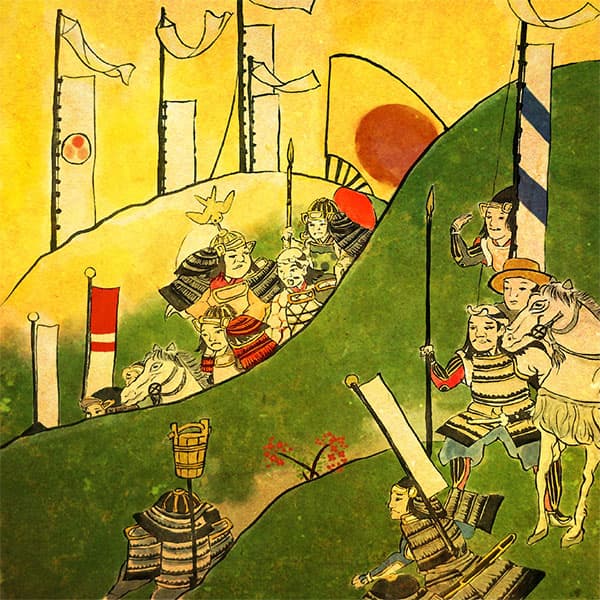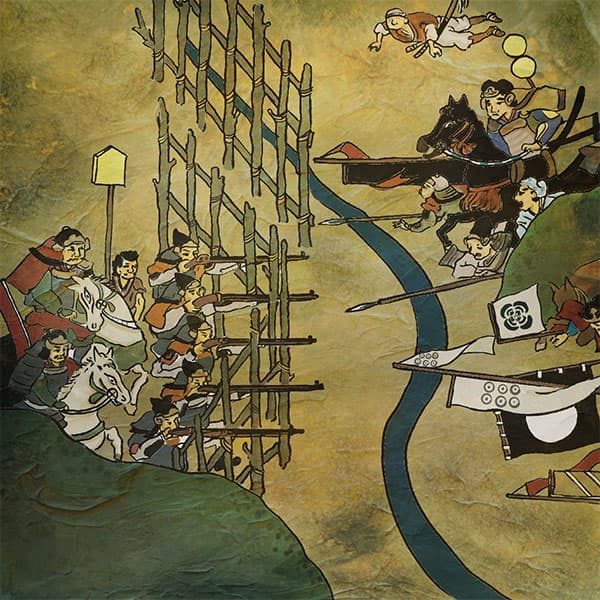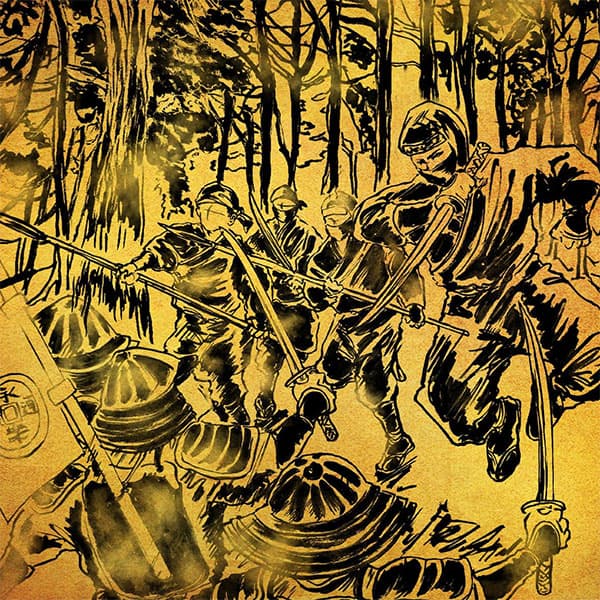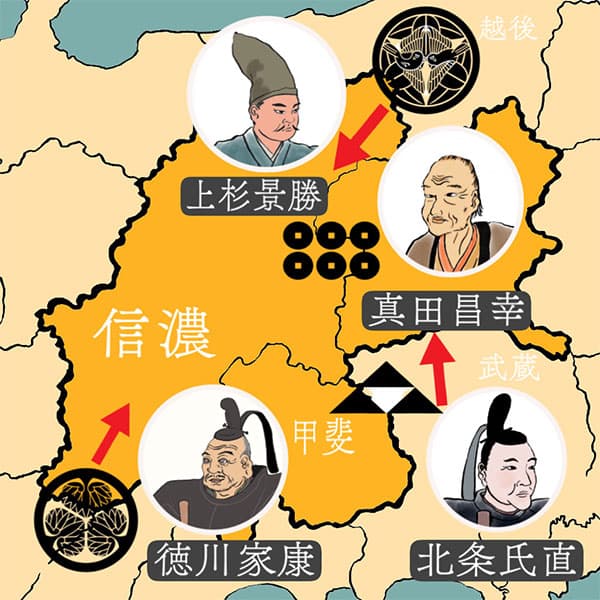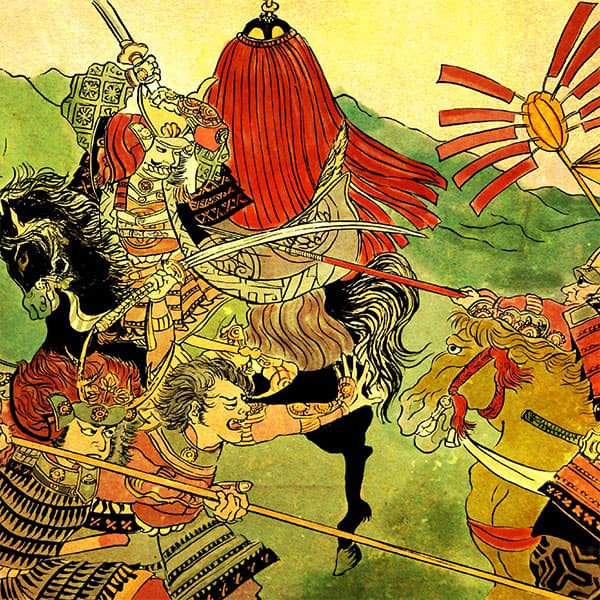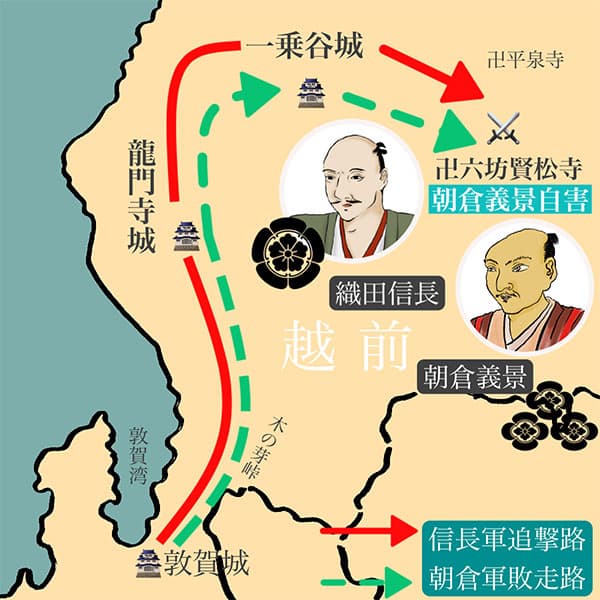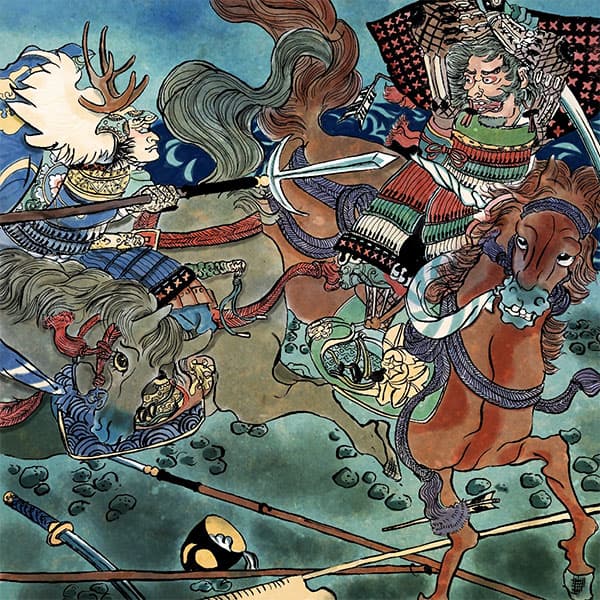Tokugawa Ieyasu (1/2)The ruler who ended the Sengoku period

Tokugawa Ieyasu
- Article category
- biography
- name
- Tokugawa Ieyasu (1543-1616)
- place of birth
- Aichi prefecture
- Related castles

Edo castle

Hamamatsu Castle

Sunpu Castle

Okazaki Castle

Fushimi Momoyama Castle
- related incident
What impressions do you have of the Sengoku period?
For example, the three great heroes of the Sengoku period were Oda Nobunaga, Toyotomi Hideyoshi, and Tokugawa Ieyasu. Ieyasu established the Edo Shogunate after the Battle of Sekigahara in 1600.
Born in Okazaki, Mikawa (present-day Aichi Prefecture), Ieyasu brought an end to the war-torn world and was appointed by the Imperial Court as the Great Shogun. In 1603, he laid the foundation for the Edo Shogunate, which lasted for 260 years. This time I will introduce Tokugawa Ieyasu.
From childhood to Genpuku
Tokugawa Ieyasu was born at Okazaki Castle in 1543 as the eldest son of Hirotada Matsudaira, a small feudal lord in Mikawa Province (present-day eastern Aichi Prefecture).
Her mother was Odai, the daughter of Tadamasa Mizuno (Dentsuin). Ieyasu's childhood name was Takechiyo.
When he was three years old, his mother's older brother, Nobumoto Mizuno, allied with the Oda family of Owari Province (present-day western Aichi Prefecture), so his father, Hirotada, who was hostile to the Oda family, divorced his mother, Odai. Takechiyo was separated from her mother when she was three years old.
In 1547, at the age of 6, Takechiyo was sent to Sunpu as a hostage by the Imagawa clan. The Matsudaira family was subordinate to the Imagawa family, the lords of Suruga and Totomi.
However, on his way to Sunpu, he was betrayed by Yasumitsu Toda of Tahara Castle, who stopped by, and was sent to the Oda family in Owari Province. However, since Hirotada remained subservient to the Imagawa clan, Takechiyo was kept as a hostage in the Oda family for two years.
Two years later, his father Hirotada passed away. Yoshimoto Imagawa, who was protecting the Matsudaira family, regained Takechiyo through a hostage exchange. Takechiyo was directly transferred to Sunpu, and Okazaki Castle was ruled by a castle lord dispatched by the Imagawa clan.
In March 1555, Tokugawa Ieyasu celebrated his Genpuku under the Imagawa clan. He was given an epithet by Yoshimoto Imagawa and took the name Jirozaburo Motonobu, and was married to Yoshimoto Imagawa's niece Sena (Sekiguchi Chikainaga's daughter). Tsukiyama-dono).
His name was later changed to Matsudaira Kurando Samotoyasu, which was a nickname for his grandfather, Matsudaira Kiyoyasu.
At the time of Ieyasu's Genpuku celebration, there was a large-scale rebellion among the local people in Mikawa Province. In February 1558, he attacked Terabe Castle, owned by Shigetatsu Suzuki, who had defected from the Imagawa clan to the Oda clan. This was Ieyasu's first attack, burning down the castle and destroying the surrounding villages. For this war feat, he was recognized by Yoshimoto.
Independence from the Imagawa family and Oda Nobunaga
In the 3rd year of Eiroku (1560), Yoshimoto Imagawa assembled an army and headed west, aiming for Kyoto. Ieyasu also participated as a spearhead.
Oda Nobunaga was the first to resist Yoshimoto. However, Yoshimoto was killed by Oda Nobunaga at the Battle of Okehazama. Ieyasu, who was resting at Otaka Castle, withdrew.
Returning to Mikawa, they were stationed at Daiju-ji Temple, the family temple of the Matsudaira family, and then entered Okazaki Castle, where the Imagawa side had withdrawn due to the danger. From this point on, we aimed to become independent from the Imagawa family.
The following year, in the 4th year of Eiroku (1561), Ieyasu presented a running horse called Arashi-Kage to the shogun Yoshiteru Ashikaga, and by building a direct relationship with the Muromachi shogunate, Ieyasu tried to gain the shogunate's recognition as an independent feudal lord. .
Furthermore, they attacked Ushikubo Castle, which was the base of the Imagawa clan in Higashi Mikawa, making it clear that they wanted to become independent from the Imagawa clan.
After that, Ieyasu won the Battle of Fujinawate and other battles, and captured various castles in Nishi-Mikawa.
With the mediation of his uncle Nobumoto Mizuno, who had given up on the Imagawa clan and formed an alliance with the Oda clan, he made peace with Nobunaga, severed relations with the Imagawa clan, and formed an alliance with Nobunaga (Kiyosu Alliance).
Ieyasu and Nobunaga met, confirmed the alliance and solidified their relationship, and later, as proof of the alliance, an engagement was signed between Nobunaga's eldest son Takechiyo (Nobuyasu) and Nobunaga's daughter Gotoku.
In 1563, he changed his name from Motoyasu to Ieyasu, giving up the character ``Gen'' which was an epithet from Yoshimoto.
In 1564, the Mikawa Ikko Ikki broke out, but it was suppressed after much effort. In this way, after eliminating the uncertainties surrounding Okazaki, they pushed forward with their strategy against the Imagawa clan. He brought in local powerhouses such as the Toda clan and the Saigo clan of Higashi Mikawa to his side, and eliminated hostile forces such as the Udono clan who had strong ties with the Imagawa clan.
In the 9th year of Eiroku (Eiroku 9), the Imagawa clan was slow to respond to Mikawa Province due to the rebellion of the people of the country that occurred in Totomi Province. By 1566, they had conquered Higashi Mikawa and Oku Mikawa (northern part of Mikawa Province) and unified Mikawa Province.
At this time, Ieyasu strengthened his control by entrusting the Nishi Mikawa Shu to Kazumasa Ishikawa and the Higashi Mikawa Shu to Tadatsugu Sakai.
In addition, in order to unify Mikawa Province and legitimize his rule, he approached the Imperial Court in Kyoto and was appointed Jugoi (Junior Fifth Rank, Lower Mikawa no Kami), and at the same time changed his name to ``Tokugawa.'' From this point on, Ieyasu took the name Tokugawa Ieyasu.
This surname of ``Tokugawa'' was changed for convenience, as Matsudaira would be a hindrance to the appointment of the governor of Mikawa due to imperial court precedent. Therefore, for the time being, Ieyasu was the only one who took the Tokugawa surname.
Imagawa invasion and Takeda Shingen
In the 11th year of Eiroku (1568), when Takeda Shingen of Kai Province began an invasion of Imagawa territory Suruga (Suruga Invasion), Ieyasu formed an alliance with the Takeda clan, with Tadatsugu Sakai as his deputy, on the condition of cession of Totomi Province, and Totomi Province. He invaded Imagawa territory and captured Hikiba Castle.
Regarding the division of the Imagawa territory with the Takeda clan, it was said that the Tokugawa clan had an agreement with the Oigawa River, with Suruga Province in the east as Takeda territory and Totomi Province in the west as Tokugawa territory.
However, in the 12th year of Eiroku (1569), Takeda vassal Torashige Akiyama (Nobutomo) invaded Totomi Province (present-day western Shizuoka Prefecture) from Shinano Province (present-day Nagano Prefecture) and became hostile to the Takeda clan.
Amid tensions with the Takeda family, Ieyasu surrounded Imagawa Ujizane's Kakegawa Castle, which had moved from Sunpu Castle, and after a battle of sequestration, he called for the surrender of the castle, surrendered Ujimasa, and brought Totomi Province under his control. I placed it (Totomi Invasion). After protecting Ujima, Ieyasu defeated the Takeda army with the help of Ujiyasu Hojo.
In 1570, he moved from Okazaki to Hikuma, Totomi Province, renamed it Hamamatsu, built Hamamatsu Castle, and made it his base.
In 1572, the shogun Ashikaga Yoshiaki, who was at odds with Nobunaga, assembled anti-Oda forces including Takeda Shingen, Asakura Yoshikage, Azai Nagamasa, and Ishiyama Honganji Temple, and plotted a siege network for Nobunaga. Takeda Shingen, who sided with Yoshiaki Ashikaga, began an invasion of the Tokugawa territories of Totomi Province and Mikawa Province (Nishigami Operation). Ieyasu requested reinforcements from Nobunaga, but Nobunaga was also having trouble dealing with the encirclement, and was unable to receive sufficient support from the Oda family, so he ended up fighting against the Takeda army.
The main force of the Takeda army moving westward approached Hamamatsu Castle, but it leisurely passed through Hamamatsu Castle and proceeded as if to invade Mikawa Province. When Ieyasu heard this, he pursued the Takeda army, contrary to the advice of the generals who had come from the Oda clan to reinforce them, calling for a siege.
However, as a result, they fought against the waiting Takeda army, incurring more than 1,000 casualties, and the Tokugawa-Oda combined army suffered a crushing defeat (Battle of Mikatagahara). However, when Shingen became ill, they retreated to Nagashino Castle, and when Shingen passed away, the Takeda family withdrew.
Due to the failure of the Takeda family's Nishigami operation, Nobunaga destroyed the anti-Oda forces, and Ieyasu also regained his power.
In response, Shingen's successor, Katsuyori Takeda, also went on the offensive, and Ieyasu continued to confront the Takeda family. In the 3rd year of Tensho (1575), they fought against the Takeda clan with their main forces in the Battle of Nagashino, and the Takeda clan suffered a crushing defeat, losing many of their key vassals from the Sukuro class, but even after the Battle of Nagashino, they never faced the Takeda clan. Continue.
Meanwhile, Nobunaga accused his legal wife, Tsukiyama-dono, and his eldest son, Nobuyasu Matsudaira, of secretly communicating with the Takeda clan.
Ieyasu sent Tadatsugu Sakai as a messenger to negotiate with Nobunaga, but Tadatsugu generally approved of Nobunaga's questioning, so Nobuyasu was notified of seppuku. After careful consideration, Ieyasu prioritized maintaining his alliance with Nobunaga and decided to build a Tsukiyama. He killed the lord and forced Nobuyasu to commit seppuku.
In 1582, Nobunaga launched a full-scale invasion of Takeda territory in collaboration with Ieyasu and the Hojo family. In response to the Oda army's invasion from the Shinano direction, the Tokugawa army also invaded from the Suruga direction and secured the Suruga territory by forcing the Takeda family's vassals to defect.
Katsuyori Takeda committed suicide on Mt. Tenmoku, and the Takeda clan fell into ruin. After Ieyasu invaded Totomi from Mikawa, he faced off against the Takeda family for over 10 years.
Death of Oda Nobunaga and Toyotomi Hideyoshi
In 1582, at the invitation of Oda Nobunaga, he visited Azuchi Castle, his residence, for a ceremony to celebrate the arrival of Suruga. After visiting Azuchi, we went sightseeing in Sakai at Nobunaga's recommendation. However, the Honnoji Incident occurred in Kyoto, and Nobunaga committed suicide.
At this time, Ieyasu was in an extremely dangerous situation because he had a small number of senior retainers and peasants. However, they barely made it back to Mikawa Province by sea from Ise Province, passing through Katakoshi through the steep mountain roads of Iga Province (Kami-kun Iga-goe).
Ieyasu returned to Mikawa and began preparing to take revenge on Nobunaga, but at the same time, he began to take control of Kai (present-day Yamanashi Prefecture), Shinano (present-day Nagano Prefecture), and Ueno, which had recently been transferred from the Takeda family to the Oda family. (currently Gunma Prefecture). Ieyasu dispatched the Takeda clan's remaining vassals, Okabe Masatsuna and Yoda Nobaba, to persuade the former Takeda clan vassals, while leading an army of 8,000 people to enter Kai Province and annex it (Tensho Migo War).
However, the Hojo family in the Kanto region also led an army of 55,000 men and crossed the Usui Pass to invade Shinano Province.
Ieyasu faced off against the Hojo forces. At this point, an all-out confrontation between the Tokugawa army and the Hojo army appeared, but Masayuki Sanada, who had served Hojo, defected to the Tokugawa army, and the Hojo army, who lost their will to fight in front of the Tokugawa army's relentless guerrilla tactics, He sent Sessai as a messenger to ask Ieyasu for peace. Ieyasu made peace with the Hojo family and formed relatives and alliances, and at the same time annexed Kai and Shinano, becoming a great daimyo who controlled five countries including his former territories of Suruga, Totomi, and Mikawa.
While Tokugawa Ieyasu was annexing Shinano and Kai, his vassal Hideyoshi Hashiba rose to power in the Oda family after Nobunaga's death. In order to defeat Akechi Mitsuhide, who forced Oda Nobunaga to commit suicide at Honnoji Temple, and to legitimize his own position, he supported Oda Nobunaga's second son, Oda Nobuo, but after that, Nobunaga's grandson Sanboshi (Oda Hidenobu) Hideyoshi and Nobuo came into conflict because he promoted him as the heir to the Oda family. Therefore, Nobuo approached Ieyasu and decided to oppose Hideyoshi.
Ieyasu and Hideyoshi brought together their armies and faced off in Owari, but during the confrontation, Nagayoshi Mori, Tsuneoki Ikeda, and others from Hideyoshi's side dispatched troops to Mikawa Province.
Realizing this, Ieyasu pursued Mori Nagayoshi and Ikeda Tsuneoki who were invading Mikawa Province.
The two armies clashed at Nagakute, and the Tokugawa army repulsed the Mori and Ikeda forces (Battle of Komaki and Nagakute). After that, the Battle of Komaki and Nagakute continued without a full-scale conflict between the Hashiba and Tokugawa armies. Hideyoshi and Ieyasu/Nobuo made peace, and as a condition of peace, Hideyoshi adopted Ieyasu's second son Ogimaru (Hideyasu Yuki).
In 1585, Hideyoshi was appointed Kanpaku and established the Toyotomi government. During this time, Ieyasu and Hideyoshi were in a cold war, and Ieyasu showed no signs of subjugating him.
In 1586, Hideyoshi tried to placate Ieyasu through Nobuo Oda and offered his younger sister Asahihime (Nanmeiin) as his legal wife, and Ieyasu accepted her as his wife, and Hideyoshi and Ieyasu became brothers-in-law. He also sent his birth mother, Omandokoro, to Okazaki to visit Princess Asahi. At this point, Ieyasu went to Kyoto, had an audience with Hideyoshi at Osaka Castle, and announced that he would serve the Toyotomi family.
Kanto transfer
In December 1587, the Toyotomi government issued the Kanto and Oku Ryogoku Sōkoku Edict, entrusting Ieyasu with the oversight of Kanto and Oku Ryōgoku (Mutsu Province and Dewa Province).
- related incident

- WriterTomoyo Hazuki(Writer)I have loved history and geography since my student days, and have enjoyed visiting historical sites, temples and shrines, and researching ancient documents. He is especially strong in medieval Japanese history and European history in world history, and has read a wide range of things, including primary sources and historical entertainment novels. There are so many favorite military commanders and castles that I can't name them, but I especially like Hisashi Matsunaga and Mitsuhide Akechi, and when it comes to castles, I like Hikone Castle and Fushimi Castle. Once you start talking about the lives of warlords and the history of castles, there's a side of you that can't stop talking about them.







